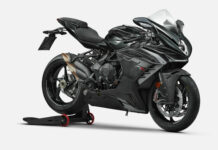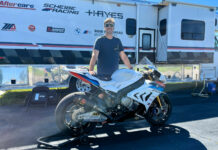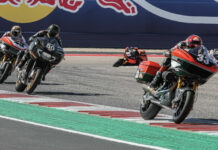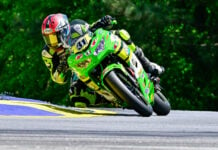From an Aprilia press release:
MS Aprilia Racing Press Information
Tuesday 9 July 2002
PREVIEW
Donington Park (Great Britain): Eighth round of the World Championship
The 2002 Donington race marks the half-way point in this season’s programme. Donington Park, deep in the English countryside, is just a short ride from Sherwood Forest, the home of legends – the Sheriff of Nottingham and Robin Hood – of a bygone age. Another age indeed, but this is a historic circuit: harmonious, technical and surrounded by a lawn that appears more like a golfing green that escape roads for centaurs. In other sections, however, it is hard and selective, especially where tough hairpin bends test the riders’ skills to the limit. Built in 1931, it was modified a number of times after years of disuse. The latest and most radical change, which created today’s configuration, came in 1985. The circuit layout was modified partly due to the proximity of the East Midlands airport, since burnt kerosene from the aircraft was making the tarmac dangerously slippery. The undisputed home of North European bikers, and with a demanding and skilled public, Donington Park is probably one of the finest circuits in all Britain. A never-ending rise and fall, with high-speed downhill bends, breakneck exits and rapid accelerations. The scene of numerous exploits of British riders, everything is set for what should certainly be one of the great races of the year.
The circuit: 4,023 metres – left curves: 4 – right curves: 7 – longest straight: 564 metres – maximum width: 10 metres – built in 1931 – modified in 1985.
2001 winners. 125 Class: Ui (JAP) Derbi – Class, 250 Class: Kato (Jap) Honda – 500 Class: Rossi (Ita) Honda.
Circuit records – 125: 1’38.626, Ui 2001 – 250: 1’34.096, Kato 2001 – 500: 1’32.661, Crafar 1998.
MARCO MELANDRI – 250cc class – Aprilia RSW 250
Marco Melandri’s most important engagement during the week was the press conference for the initiative to assist Emergency, which was presented to the media yesterday in Milan. Marco Melandri and Aprilia have decided to donate a number of parts of the Spiderman-design motorcycle which Marco rode to victory in the Italian Grand Prix to the humanitarian aid association run by Dott. Gino Strada. The fairings, racing suit, crash helmet, gloves and boots have been donated to Emergency, as has the “Spiderman” SR 50 scooter Marco used in the paddock area. The online auction is being held by Ebay (www.ebay.it) and will help raise funds for the hospital for civilian victims of the Afghan war. In his statement, Marco expressed his determination to spread a message of solidarity:
“I was truly struck by pictures from the hospital in Afghanistan which Emergency showed at the press conference. They’re harsh and crude, and they’ve given me an even greater urge to make known the message of those who work with such dedication and love for those who are suffering so much. I think anyone who’s as lucky as me should do all they can to provide real assistance to those whose main problem is that of mere survival. I do hope the proceeds from the auction to collectors of sports memorabilia will give a real help to Emergency and to those who are suffering in Afghanistan today. So I’d like to make a plea to those collectors who are competing to secure parts of my bike to remember that, more than anything, this is a “solidarity race”.
REGIS LACONI – MotoGP – Aprilia RS3
Birthday week for Régis Laconi. After starring as a guest in two sports programmes in Italy, the Italo-French rider returned to his parents’ home in France to celebrate two birthdays. Régis turned 27 and then, a couple of days ago, his companion Aurelie made 25. As the RS Cube was winning an award as the motorcycle with the most exciting sound – in the opinion of the readers of a famous Dutch journal at Assen – all eyes were turning to preparations for this weekend’s race at Donington Park.
“It’s a technical and selective track”, says Régis Laconi. “One of those tracks where the rider needs real passion. In actual fact, the technical features might make you think there are two completely different tracks. Part of it’s harmonious and smooth, with downward slopes of over 200 kph, but then there’s a second, tortuous part, with two highly technical, very difficult hairpins. The second, downhill one which leads into the finishing straight in particular. It takes sharp braking, especially in this part of the circuit – and it also means the engine brake needs to be set with absolute precision. To give you an idea, there are straights where you open up the gas to the full before taking these two 180° bends in first gear. Rather like at Le Mans but even more difficult to negotiate. Coming out of these two tight corners, you’ve got to be able to deliver all the power you’ve got down to the ground so you can make the very most of the straights that open up in front of you.”
TECHNICAL BRIEFS:
The RS3 Chassis
The chassis of a motorcycle is one of the most important components.
The chassis determines the overall geometry of the motorcycle and also determines the bike set-up (steering angle, trail, etc.); furthermore, the chassis must transmit the engines power to the ground and therefore work efficiently with both suspensions and tyres.
Infact, the initial objective of the RS3 chassis was to transmit the engine power to the ground, and at the same time transmit the right sensations to the rider to help him improve the bike set-up.
The ergonomics of the chassis was another major factor considered during its design.
The rider position was carefully studied and in collaboration with the aerodynamic analysis, the best compromise between rider mobility and aerodynamic protection was chosen. This phase of the project was one of the most laborious, since the width of the engine exceeded any previous projects and past references always minimised the frontal area.
Once the external (ergonomic) and internal (engine) dimensions of the chassis were frozen the chassis design truly commenced.

The chassis and all its details were completely designed using 3-dimensional CAD; therefore creating a virtual chassis on the computer. Once the virtual chassis was completed, the 3-D model was used to produce a prototype. A 1:1 scaled prototype of the chassis was produced using stereolithography (SLA); a rapid prototyping technique that uses a single laser beam to convert a liquid plastic monomer into a solid polymer upon exposure to UV light.
Rapid prototyping is becoming an, evermore, important tool. It allows you to work on a real life piece, identical to the final component, a long time before traditional manufacturing techniques would permit.
The prototype produced was used to complete the motorcycle (cooling system, exhaust layout, etc.); reducing the time necessary to finalise the motorcycle, while the chassis model was undergoing a structural analysis.

The 3-D model produced using the CAD software was used to carefully analyse the chassis structure, especially the structural parameters that may influence the chassis efficiency on the track, such as, torsional stiffness, etc. Furthermore, the finite element analysis (FEA) was used to optimise the relationship between the chassis’ stiffness and weight, and to remove all high-tension areas that might cause structural failure.
Since the number of chassis’ needed for the MotoGP season was limited, the decision was taken to consider all chassis’ produced as prototypes, therefore not investing in expensive machinery. Moreover, this assured a certain level of flexibility for future development.
Most of the parts that make the RS3 chassis and swing arm were manufactured using high definition and high-speed CNC machines with good precision and quality finishing.
Therefore, many components that make the RS3 were originally aluminium blocks; or in other words “cubes”.
From a Suzuki press release:
Team Suzuki News Service
HOME RACE PROMISE FOR SUZUKI TEAMSTERS
MotoGP, Preview, Round Eight, British GP, Donington Park – July 14, 2002
THE British GP at Donington Park marks the halfway point of the 2002 MotoGP season, and the Telefónica MoviStar Suzuki team hopes to prove the progress achieved with its racer at a track with a special character.
The GSV-R V4 – put onto the race-tracks a year earlier than originally planned – has already established itself as a serious threat to the top five positions, in spite of being the newest of the three Japanese 990cc four-stroke MotoGP prototypes.
Development of the booming blue baritone has been impressive, but it remains frustrating for the riders, tantalisingly close to the target of being fully competitive, and impatient for even more improvements than those already achieved by a factory racing department working at full steam.
The latest round of improvements – a revised chassis and new crankcases – marked another step, with one of the Suzukis on the front row of the starting grid at both the Catalunyan GP and the Dutch TT, and Sete Gibernau setting the pace in wet practice sessions at Assen.
Former 500cc champion Kenny Roberts finished well up in the top 10 at each of those races, with sixth in Holland as proof of the steady progress. But the American is anxious to do even better, and the sinuous curves of Donington Park give him and team-mate Sete Gibernau another chance to do so.
“We have an international team, but with our base in Kent this is the closest we come to having a home GP,” said Garry Taylor, manager of the factory team.
“We always hope to do well at Donington, and we have had a lot of success there in the past. Things are more unpredictable this year, with the new four-strokes racing for the first time, but the track is the same, and we know we have some particular strengths that should work in our favour there.”
One of these is the riding skill of both team members. Roberts in particular has achieved excellent results at the parkland circuit, finishing an inch-close second there in 2000 after a thrilling race-long three-way battle with 2001 champion Valentino Rossi and Aprilia-mounted British star Jeremy McWilliams.
Donington is a unique circuit, described by technical adviser Warren Willing as being “two tracks in one”. The first two thirds of the 2.5-mile lap comprises of flowing sets of corners, one running into the next, which reward good machine handling and rider skill alike. The Suzuki team has both of these weapons in the armoury.
The final third is very different: a slow chicane and two hairpin bends linked by short straights. Here, the flowing technique must be abandoned, in favour of fierce braking and brutal acceleration – a point in favour of the four-strokes against the lighter but less powerful 500cc two-strokes.
“Ever since the start of the season, we have had an almost continuous stream of upgrades from the factory,” continued Taylor. “The rate of progress from the factory has been incredible … but you always want more, especially when we are this close to success. For this race, we have the same equipment as at the last two rounds, with more to come for the next race.”
Another strength has come from the class-leading Michelin tyres. The team reverted to the French brand after the first two GPs, but at first had to use 2001 tyres while Michelin upgraded its production capacity. “For the last two races, we have had the latest tyres, which gave us another boost,” said Taylor. “We hope to keep up the progress at Donington Park on Sunday.”
KENNY ROBERT Jr. – GOING FOR THE MAXIMUM
“I was disappointed after Assen because we’d had such good tests after the previous race at Barcelona, and I expected to be closer to the front guys. I’m not here to finish seventh or eighth – I’m here to beat Valentino Rossi in the last two laps. That’s what I’ve trained to do all my life, and I know I can do it. But we still have to work hard to get our new bike ready to do that. Meantime, I’m still motivated, and I’m having fun – because our bike is getting better all the time. Donington’s a tough race-track, and my agenda is the same as always – to achieve the maximum possible from myself and the bike.”
SETE GIBERNAU – HEAD DOWN, WORKING HARD
“I won’t pretend I’m not feeling frustrated after crashing out of the last two races. Both times I was pushing to the absolute maximum. I think everybody can see I’m working my hardest, and my team is doing the same. Also the factory. We’re not yet where we want to be, and where I believe I should be. Until we get there, I just want to keep my head down and keep working.”
ABOUT THIS RACE
The British round was one of the six original races on the first World Championship calendar of 1949 – but in those days, it was held on the Isle of Man. It was the TT, dating back to the dawn of motorcycle racing and reflecting generations of enthusiasm for the sport. The first TT was held in 1907, and when the modern world championship was founded after the Second World War, this week of racing was adopted as the British round. The race moved to mainland Britain in 1977, to be run at Silverstone for 10-years after the public-roads Manx circuit was judged too dangerous for modern racing. It moved to Donington Park in 1987 after the length was specially extended to match the FIM minimum. This is the 16th running of the GP at the track outside Derby, bordering on the East Midlands airport – and organisers are hoping for a second year with handsomely boosted spectator attendence. The revival began last year, after five years of flagging figures and empty banks as British fans switched their attention to production-based Superbike racing instead. In 2000, there were only 18,000 spectators; last year double that number, and this year advance ticket sales stood at more than 30,000 a week before the race.
ABOUT THIS TRACK
Donington Park was a famous racing venue before the war, but the original circuit was lost when it was turned over to military use. It was revived by millionaire building contractor and racing fan Tom Wheatcroft nearly three decades later, and recently changed hands for a third time. The track has a distinct dual character – most of the lap comprises sweeping medium-speed bends blending into one another, made more technically challenging as the track drops off the hillside towards the Old Hairpin (actually a fast corner), and then climbs up again to the short back straight. Smooth riding and quick steering are at a premium in this section. The last three corners are completely different – a slow left-right chicane followed by two first-gear hairpins linked by short straight. Here riders must switch from smooth to aggressive, while acceleration and braking performance are what matter from the motorcycle.
GP FACTS
Donington Park
Circuit Length: 2.500 miles / 4.023 km
Lap Record: 1:32.661 – 97.120mph / 156.298km/h
S Crafar (Yamaha, 1998)
2001 Race Winner: V Rossi (Honda)
2001 Race Average: 46:53.349 – 95.962mph / 154.436km/h
2001 Fastest Race Lap: 1:33.056 – 96.707mph / 155.635km/h, V Rossi
2001 Pole Position: M Biaggi (Yamaha) 1:31.964
2001 Kenny Roberts: Eighth, Qualified Sixth (Telefónica MoviStar Suzuki)
2001 Sete Gibernau: 11th, Qualified Seventh (Telefónica MoviStar Suzuki)
From a Honda press release:
2002 MotoGP 500 World Championship, round 8
British GP, Donington Park
July 12/13/14 2002
ROSSI READY FOR BATTLE OF BRITAIN
The first-ever four-stroke-based MotoGP season reaches its halfway mark at Donington Park this weekend, when Honda riders aim to continue their 100 per cent record in the class. So far the factory’s stunning RC211V V5 four-stroke has dominated at every Grand Prix of 2002, winning all seven races and establishing new lap records at all seven tracks.
And the man doing most of the winning Valentino Rossi (Repsol Honda Team RCV211V) has won six of the seven races counts Donington as his second home GP of the year. The Italian is now based in Mayfair, London, so he’ll be looking for a repeat of his impressive Italian GP victory at Mugello last month, especially since he celebrates his 100th GP event this weekend.
The British GP is also a significant event for Honda. It was, after all, at the British round of the World Championships that Honda made their entry into world-level competition, competing in the 1959 Lightweight TT, counting towards that year’s 125 World Championship. Now with more than 500 wins behind them, Honda has established itself as the most successful racing marque of all time and the world’s biggest manufacturer of motorcycles.
The 220 horsepower RCVs of Rossi and team-mate Tohru Ukawa (Repsol Honda Team RCV211V) are the latest successors to the 18 horsepower RC142s that marked Honda’s entry into GP competition 43 years ago. Already clocked at over 200mph/321kmh, the RCV is proving to be a perfectly balanced motorcycle, able to win whatever the circuit, whatever the weather conditions. And the all-round performance of the Michelin-equipped RCV will be as vital as ever this weekend for the weather forecast is not great and Donington is a complex track, with two starkly contrasting sections.
“I hope for some sun, both for me and the fans, it’s a little like winter at the moment,” smiles Rossi. “For sure, I love Donington but it’s a very strange track, with one part with very fast corners and another part with very slow corners, like car parking. Anyway, I like it.”
Donington is one of Rossi’s best tracks. He won his first premier-class GP win there in 2000, riding an NSR500 to victory in treacherous wet/dry conditions and last year he recovered from a high-speed practice tumble, and subsequent third-row start, to score one of his most breathtaking successes. Previously he won the 1997 125 GP and 1999 250 GP at the venue, so this Sunday he goes for a fourth successive Donington win.
“I maybe make two of my best races at this track,” adds Rossi, already winner of 45 GPs. “Last year was a very big emotion, because we didn’t expect to win after the crash in practice.”
But Rossi is not assured of another victory, far from it. He has come under severe pressure from several rivals this season, but so far the only man to have beaten him is Ukawa, who won a frantic last-lap tussle at April’s South African GP. “There are several four-stroke riders who have raced me this year but I think places like Donington and Sachsenring will also be good for the two-strokes,” he reveals. “When the circuit is more slow, for sure the two-strokes can get near to us.”
Ukawa, who finished fifth at the Dutch TT after tumbling at the final turn while going for third, is determined to be back on the podium on Sunday, preferably on the step above Rossi. “I always want to finish top three, but especially at Donington,” says Ukawa, who has yet to make the podium at the British venue. “I also want to beat Valentino to close the points gap. He’s a great team-mate but also very difficult to beat!”
At Assen two weeks ago, Alex Barros (West Honda Pons NSR500) was the man who gave Rossi most to worry about. The Brazilian veteran, who has ridden 201 GPs, pushed the youngster all the way at Assen, earning fulsome praise for his efforts. “Since I came to the big class two years ago, I’ve never seen anyone ride a 500 like that,” said Rossi.
Barros is therefore well and truly pumped for Donington, where his two-stroke’s light weight and easy handling should give him another chance to beat his young rival. “This is a difficult year for us because the four-strokes are so fast,” explains the Brazilian. “But there are some tracks where we can use the 500’s advantages, and Donington is one of them. Assen gave me a lot of confidence and some time to see where I can beat the RCV. It won’t be easy, but I’m looking forward to having another go.”
Barros’ regular team-mate Loris Capirossi (West Honda Pons NSR500) is currently out of action after breaking his right forearm when he fell heavily at Assen. The Italian’s place at Donington and next weekend’s German GP will be taken by 22-year-old Alex Hofmann, who impressed at Assen, subbing for injured Yamaha rider Garry McCoy.
The former 250 GP rider aims to make the most of his second MotoGP chance.
“Last winter I lost my sponsor just five weeks before the start of the championship and since then I’ve only ridden in the German World Superbike round and the last two GPs,” says the German. “This is a fantastic opportunity. I don’t normally need much time to adapt, so I’m sure that I won’t have too many problems this time. I don’t know what I can achieve and I won’t make any promises, but Honda is the best constructor in the championship and I’m riding with a great team.”
Reigning 250 World Champion Daijiro Kato (Fortuna Honda Gresini NSR500), who dominated last year’s British 250 GP, aims to get back on track for his 500 debut at the track. Kato, who harried Rossi in May’s Spanish GP, has had a tougher time of late as he works to fully adapt to his NSR500. Twelfth at ultra-difficult Assen a fortnight ago, he feels he should go better this weekend. “Donington is a more conventional circuit, I think we can get a better result there,” says the Japanese. “You’ll see that I will come back from my last few results and run at the front again.”
Compatriot Tetsuya Harada (Pramac Honda NSR500) is also feeling in confident mood, despite some ongoing discomfort from the left shoulder he injured during preseason testing. “Every weekend I feel more comfortable on the bike,” says Harada, 1993 250 World Champion. “And I think Donington will be good for me Dunlop tyres always work well there and I scored one of my two 500 podiums there in ’99, when I was riding the Aprilia twin.”
Two weeks ago at Assen Jurgen van den Goorbergh (Kanemoto Racing Honda NSR500) scored his first top-ten result of the year, bringing the Dutchman to Britain with renewed determination. Van den Goorbergh’s main job this season is to help Bridgestone develop its new range of MotoGP tyres, and he feels the tyres get better with every outing. “I’m giving them a lot of feedback and we keep getting improved tyres,” he says. “But I wouldn’t mind if it rains at Donington. I was fastest for a while during wet Assen practice, and I feel we’re probably more competitive in the wet at the moment.”






